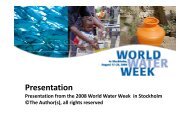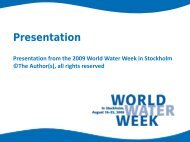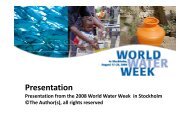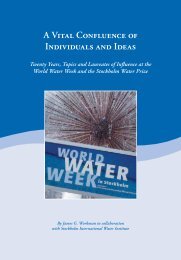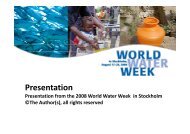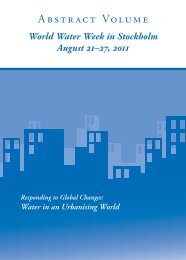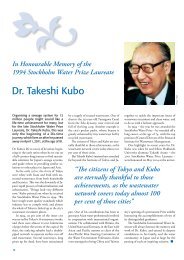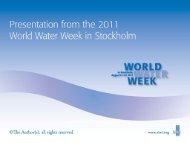FEEDING A THIRSTY WORLD - World Water Week
FEEDING A THIRSTY WORLD - World Water Week
FEEDING A THIRSTY WORLD - World Water Week
You also want an ePaper? Increase the reach of your titles
YUMPU automatically turns print PDFs into web optimized ePapers that Google loves.
August 2012We make our readers succeedIN COOPERATION WITH:Nr. 21 000 000people arestarving<strong>WORLD</strong>WATER WEEKPRIVATE DRAINS- a global issueTHE EXPERTSaddress the mostimportant questionwithin food andwater safetyPHOTO: (ESKIL ERLANDSSON) REGERINGSKANSLIET, (BACKGROUND) ISTOCKWATER & FOOD SECURITY –<strong>FEEDING</strong> A <strong>THIRSTY</strong> <strong>WORLD</strong>Eskil Erlandsson, Minister for Rural Affairs: There willalways be a demand for food. Especially high quality food.Flourishing seas, lakes and streams for the benefit and enjoyment of all.www.havochvatten.se/english
The world’s mostimportant sustainabilityFuture sewage and plumbing are facing major challenges and decisive changes. For us at Uponor, it actsas a driving force and inspiration as we work every day with solutions to make life on earth easier. With morethan 60 years of experience we develop and manufacture durable piping solutions that protects and transportsheating, water, air, electricity, telecommunication and data. And whether the solution involves a single pipe or acomplex system, we can always, with our knowledge of human needs and environment, promise that we lay thefoundation for a functioning and secure future.Uponor is a Founder of the Stockholm <strong>Water</strong> Prize since 1995.Uponor is a leading international supplierof systems for plumbing and infrastructure.The group has operations in over 100countries. Learn more about oursystems and products on Uponor.com
AUGUST 2012 · 5PHOTO: THINKSTOCKPHOTO: ANNA-KARIN NYMANPHOTO: THINKSTOCKThe goal is“Zero Hunger”QUESTION & ANSWER■ Which is the greatestchallenge for agriculture?– Seen from the wider perspective,it is working towards the goals of“Zero Hunger” which the UN SecretaryGeneral presented duringthe recent Rio+20 conference. Morefood is needed, but it must beproduced in a sustainable way anddistributed justly.■ How does the future lookfor Swedish agriculture?– The future looks good. There aregood conditions for it, good supplyof fresh water, winters whichinhibit the growth of parasites,very knowledgeable farmers anda good education for future generations.There are also otherareas closely connected to agriculturewhich are creating newconditions that contribute to aliving and strong countryside.■ What is your view onthe public’s interest insustainable agriculture ,organic cropped, localproduce and similar issues?– Ever more people are becomingmore aware about what they buyand the way food is produced. Ithink that’s really good.– It places even higher demandson the producers andon all of us who are working onagricultural issues at a nationaland international level. New demandsalso contribute to newideas and businesses, which ispositive from an employmentpoint of view.■ Which is the mosti mportant issue in agriculturein the Baltic region?– That we continue to pursue withfinding ways to make agriculturemore environmentally adaptableand sustainable. Sweden havean important role to play, and wemust help those countries whereproduction is low and in a lessenvironment friendly way.OLA HANSONeditorial.se@mediaplanet.comMinistry ofRural AffairsThe Ministry was created onJanuary 1st, 2011, when theDepartment of Agriculture, receiveda broader remit, changedits name to Ministry of RuralAffairs. The Ministry is responsiblefor a large numberof areas in agriculture , fishing,bio-energy from farming and forestry,animal husbandry, huntingand wildlife management,foodstuff, rural policy, forestryetc. Its work is carried out byfour different government unitsand four units responsible for legalissues, EU coordination, informationand administration.A number of authorities andcommittees are included in thisMinistry, such as the SwedishBoard of Agriculture, the boardof professional conduct in veterinarymedicine, the NationalVeterinary Institute, the SamiParliament, the Swedish Universityof Agricultural Sciences andthe Swedish Forest Agency.A living countrysideA principal task of the Ministryfor Rural Affairs is to worktowards a living and expandingcountryside. Its remit includesaddressing issues on ways ofcreating work opportunities andmaking good use of the naturalresources Sweden has in areassuch as the visitor industry andtourism.The Minister of Rural Affairsis the Swedish representative atthe Council of Ministers in thearea of agricultural and fisheryissues in the EU. Approximatelyonce a month the Council ofMinisters hold meetings for theministers for agriculture andfisheries in the EU.OLA HANSONeditorial.se@mediaplanet.comSwedish Aquaculture –a Green Industry in blue fieldsThe long coast, almost 100,000 lakes, and high-level qualityof water in Sweden provide the potential for producingenvironmentally friendly and good quality aquaculturalfor more enterprises capable of producing good food and– With this strategy as its basis, aquaculture can growand become one of the driving forces behind developmentand the creation of jobs in rural areas,” says Mats Persson,The Swedish Board of Agriculture, which is responsiblefor promoting aquaculture, has headed this work incollaboration with other members of the industry,researchers, non governmental organisations and otherSustainable aquaculture is the keyThe strategy envisions how Swedish aquaculture willgrow and develop in a sustainable way up to the yearfuture generations to meet their own needshave the minimum possible negative impact on theenvironmentbe characterised by good animal welfarecontribute to regional development, including thatOne of the most important goals is for consumersto recognise Swedish products and associateSwedish aquaculture with high quality, good food,Read our strategy on the aquaculture portalSwedish aquaculture is a joint authority portal forVisit www.svensktvattenbruk.se/strategifor further reading, and download the new strategy
6 · AUGUST 2012NEWSClean water: by no means a given FACTS■ In Sweden we are spoiledwith an almost unlimitedsupply of clean and fresh water.At the same time, eventsover recent years have shownthat this obvious fact is nolonger quite so axiomatic. Wehave seen how vulnerable thequality of our water is and howlittle is needed for clean waterto become in fact a healthrisk. Is it time to question howclean our Swedish water reallyis?– Yes, to some extent we must.We can no longer blow our owntrumpet and believe that Swedenstill has the cleanest water in theworld, or that our supply of cleanwater is inexhaustible and everlasting.There is a lot which needsto be done, and we cannot relysolely on technology as being thesolution to the problems whichhave arisen and which risk becominggreater in the future.This is a strong claim made byErika Lind, National Coordinatorfor Drinking <strong>Water</strong> at the NationalFood Agency, about the situationand the future.■ In November 2010, Östersundwas hit by the worst outbreakof cryptosporidium everexperienced in Sweden. Over20,000 people became ill, andthe medical costs alone werecalculated to around SEK 250million. Added to that was theloss of income for companiesand organisations, a declinein tourism and a number ofother costs. One theory is thata sewer was erroneously connecteddirectly to the surfacewater draining into the lakeStorsjön. Since the lake is oneof the most important catchmentareas in the region, theeffects were devastating.– It should not take an outbreak of awaterborne illness to open our eyesto the fact that we must find a betterway of safeguarding and preservingour catchment areas. Our naturalenvironment is not as unspoiledas we would like to think, and thetechnical systems in place cannothandle everything. Our essential resourcesmust be assured for futuregenerations.■ Therefore, the obviousquestion, is what is requiredand what must be done tosafeguard the quality of ourwater in the future?– Simply put, more resources mustbe devoted to long term management.Our faith in our water qualityin Sweden cannot be used as anexcuse to postpone measures thatneeds to be taken.■ What is your wish as theCoordinator of the work thatis done regarding the qualityof our drinking water?–The areas we must focus onrequire in-depth analysis of thecurrent and future situation, weneed to step up the work of prevention.More research and development– there is a huge amountof data not available today, as wellas knowledge gaps in importantareas. More critical studies whichillustrate the problems from differentangles. A socioeconomicanalysis is also needed to provethe water’s importance and whatwould happen if society faced problemswith the drinking watersupply, and how this would impacton the industry and socialfunctions, not least in the entirefood sector. I would like to see morecooperation and exchange of experienceat an international level.All countries, including Swedenwould benefit from having their,problems and opportunities highlightedfrom an outsider’s pointof view. This needs to be done, andit’s becoming a matter of urgency,concludes Erika Lind from the NationalFood Agency.OLA HANSONeditorial.se@mediaplanet.com■ The National Food Agencyis a supervisory authority withresponsibility for the coordinationof drinking water issues inSweden. The Agency’s drinkingwater regulations concerntreatment, distributionand quality of the country’sproduction of drinking water.The Swedish Commission onClimate and Vulnerability reportpresented in 2007 indicated therisk that extreme weather conditionsand their effects suchas landslides will place higherdemands on the productionof safe drinking water. TheGovernment made the decisionthat the National Food Agencyshould have overall responsibilityof coordinating the workbetween government departmentsand agencies who sharethe responsibility for drinkingwater from catchmentareas to kitchen tap. It is alsothe Government’s assessmentthat substantial funding will beneeded to assure the futuresupply of clean drinking water.■ National network fordrinking water is a networkconsisting of sector representativesin the government agenciesand trade organisationsmost affected by the issueof clean drinking water wascreated by the National FoodAgency in 2010. The networkincludes the National Board ofHousing, Building and Planning,the National Food Agency,the Swedish Agency forMarine and <strong>Water</strong> Management(SwAM), the NationalBoard of Health and Welfare,the Geological Survey ofSweden (SGU), the Swedish<strong>Water</strong> Authorities (representedby the County AdministrativeBoards), the SwedishInstitute for CommunicableDisease Control), the Swedish<strong>Water</strong> and WastewaterAssociation (SWWA) andthe Swedish Association ofLocal Authorities and Regions.The network’s threeworking groups for researchand development, crisis preparednessand strategic planningalso includes members ofgovernment agencies, countyadministrative boards, drinkingwater providers, institutes anduniversities , local authoritiesand consulting firms.!Read moreon the web:slv.under the headline DricksvattenDo you want to be my guardian angel?SeeGive neglected children a home, a family and a future.thevulnerablechildrenLosing one’s parents is probably the worst tragedy that can befall achild. At the same time, there can also be a purely practical crisis toface: where will I live? How will I get food to eat? Who will care for me?Läkarmissionen has been working to help vulnerable children aroundchild who has been orphaned is to grow up in a “normal” family. It couldbe almost any sort of family, in fact, as long as the child can feel lovedand safe there. We have been involvedSubmit your donation to 90 00 21-7. Write “GuardianAngel”on the counterfoil. Or text ÄNGEL100to 72 980 and donate SEK 100.in initiating a completely new way of helping vulnerable children inSouth Africa. The results are so fantastic that we now want to give thisopportunity to help to many more people. We are therefore asking you:Would you like to be a “Guardian Angel” for abandoned and orphanedchildren? If so, you will be providing support along the wholejourney from the time of crisis to the child becoming part of a new family.Could anything be more meaningful than that? Thank you for yourcontribution. For further reading, visit www.lakarmissionen.se
A majority of Sweden’smunicipalities collaboratewith ALcontrol ABDo you want to know why?Visit www.alcontrol.sewww.alcontrol.seA common world.A common water.The work of the Swedish Agency for Marineand <strong>Water</strong> Management is commissioned bythe Swedish government and is for societyat large. Here you will find all the currentknowledge on our marine and freshwaterenvironments. Our work crosses borders,both within and outside Sweden.The Agency was established on 1 July 2011.www.havochvatten.se/english
8 · AUGUST 2012NEWSQUESTION & ANSWERFood Safety■ The terms ”food security”and ”food safety” can soundconfusingly similar. Can youexplain these?”Food security” means ensuringaccess to food for everyone, while”food safety” means that foodshould not influence humanhealth. This might concern bacteria,viruses or chemical substancesin food which shouldnot be found in quantities thatcan threat human health.PHOTO: THINKSTOCK1000000 peopleARE STARVING■ Question: One billionof increasing harvests. In Africapeople in the world are”Think how much the use of artificial fertiliser is onstarving. Why is that?average 7-9 kg per hectare, comparedto 100-150 kg in Europe.■ Answer: -It is not becauseof lack of food. Studiessave if we gotHowever, it must be done in thewater we mightshow that the total populationof the OECD countries th-to grips with the ser does not contribute to the eu-right way so that the use of fertilirowaway as much food as thetrophication of watercourses andwastage”total food produced in Sub-other damage. In many parts ofSaharan Africa; the problemthe world water resources are scarce,while in other parts access to itis rather that there is food, butMathilda Åbergnot where it is needed,saysis patchy, and a whole year’s rainfallcan occur in a period of a fewSenior Advisor at the Ministry of Rural AffairsMathilda Åberg, Senior AdvisorPHOTO: PRIVATEat the Ministry of Rural Affairs.days or weeks. In addition, climatechange and other environmentalproblems lead to poorer harvests,the spread of desert and soon. When food prices increase, thoseliving in developing countriesseldom have any margins.SHOWCASENatural catastrophes, high foodprices, unemployment, conflictand decreased investment inagricultural production - theseare just some of the reasons whyso many are starving. Parts of Asiaand Sub-Saharan Africa are theworst areas, and a million childrenunder the age of five risk dyingof starvation. Furthermore, it isestimated that the world, populationwill have increased to twobillion by the year 2050. If everyonewill be able to eat enough, agriculturalproduction must increaseby as much as 70 percent. Thatis if the West doesn’t change itsconsumption patterns.Economising on water-Here in Sweden we throw away100 kg of edible food per person peryear, Mathilda Åberg says.-That amounts to an enormousmacroeconomic cost. (Reducingthis wastage could save SEK 11-20billion.) If we make better use offood we will contribute to both ourlocal and the global environment.Food production is also intimatelyassociated with access towater and energy. Manufacturinga kilo of flour requires as muchas 1,500 litres of water, and meatis of course an even greater drainon resources. In fact, agriculturerepresents as much as 70 percent of the world’s total waterconsumption.-Think how much water we mightsave if we could manage theFACTS■ Millennium Goals:■ To cut extreme poverty andhunger by half between 1990and 2015. The proportion of theworld population living in extremepoverty has decreased,which indicated that we canclaim success. The proportionof those suffering from hungerhas also decreased, if not byas much, but the number hasbeen constant.■ What is Sweden doingabout the hunger problem?■ Sweden is a majorcontributor to organisationssuch as the FAO, the UN Foodand Agriculture Organisation,whose focus is on long term effortsto address global agriculturalissues.We also contributeto the <strong>World</strong> Food Programme,the organ providing emergencyfood aid at times of famine, andto IFAD, the organ providingwastage, Mathilda reflects.-If agricultural production is toincrease, we must get better at economisingwater and finding newand more resource -efficient agriculturalmethods.Artificial fertiliser is one wayassistance to smallholders.■ Tips:■ Make conscious choices atthe supermarket. Think aboutwhere the food you buy is produced.Has the fish been farmedin sustainable stocks?How far have the apples beentransported? Is the price warranted,bearing in mind what itcovers? Ask questions in thesupermarket and at the restaurantabout where the food wasproduced. If you are providedwith answers, it indicates thatthe business is well managed.If you have the possibility tomake donations, please do soboth at times of catastrophesand to support more long termefforts.Read more! on the web:www.fao.seThe millenium goals-We should remember that thecost of food in Sweden seldomexceeds 15 percent of a family’s income,Mathilda Åberg says.- If the prices increase, we caneasily cut down on something else,but in poor countries food can oftencost half of one’s income. If itbecomes more expensive, schoolingand doctor visits might nolonger be affordable.Despite the Millennium Goalsand a large number of targetedefforts, the number of starving hasbeen relatively constant for a longtime. Being able to eat satisfied isnot enough. Food must also be sufficientlynutritious and varied. Especiallyfor children.-One usually talks about theimportance of the first thousanddays, and this includes pregnancy,Mathilda Åberg says. Undernourishmentduring this period in lifeinhibits both growth and intellectualcapacity.BENEDIKTA CAVALLINeditorial.se@mediaplanet.com■ Can we depend on foodbeing safe?The EU has common rules andregulations which are regularlyupdated in order to meet thestandard of competence whichis constantly increasing in thisarea. There are also standardswhich apply globally. The developmentof these standards isundertaken by an intergovernmentalorganisation, CodexAlimentarius, which was createdat the beginning of the1960s by the UN organs FAO andWHO with the purpose to createinternational rules - standards- for food safety, probityin food handling and free trade.At present Codex has 185 membercountries. It is essential thatthe developing countries areable to participate in the workat a global level in food safety.In order to help enhance thelevel of participation of its membercountries, a special fund hasbeen founded, known as theCodex Trust Fund, and Swedenis one of its major contributors.Codex standards stipulate themaximum permissible contentof certain chemical substancesin foodstuffs.GuidelinesRegarding drinking waterand health, WHO has developedDrinking <strong>Water</strong> Guidelinesto support the legislationin each country. The Guidelinesinclude benchmarks fordifferent chemical substancesin drinking water. The EU hastacit laws regarding the qualityof drinking water, these areoften in line with the WHO Guidelines.How can you know if a foodstuff(i.e. the chemical substanceit contains) is safe?Current scientific knowledgeis used for determining whichcontent level does not pose ahealth risk even if you are exposedto that substance everyday of your life. Based on this itis decided which content levelsare acceptable in different typesof food - levels known as thresholdvalues. Food with a highercontent than the threshold valuemay not be sold. The EU hassometimes stricter thresholdvalues for pesticide residues infoodstuffs than in other parts ofthe world.
12 · AUGUST 2012INSPIRATIONWATER SUPPLYPHOTO: BRITTA SÖDERBERGSurface water –an ever growing challenge■ Question: The rainysummer and all the fl ooding isonly the beginning of a growingproblem. Given the climatechange, the amount of rainfallis expected to increase. Howcan we manage and treat allthis water?■ Answer: There are severaldifferent methods for treatingsurface water.HOW WE SUCCEEDWATER PURIFICATIONSurface water is the name given torainwater which falls on houses,open roads and urban streetsand is then conducted away withthe aid of wells. In the past, surfacew ater was allowed to flowout untreated into the nearestwatercourse , lake or sea, but this isnot a good solution.– Surface water contains manypollutants, says Emil Eriksson, anexpert in surface water treatment.– There is also an EU Directive stipulatingthat surface water mustbe treated.Most of the pollutants in surfacewater come from motor traffic andare tied to particles. If the water isallowed to lie dormant, these sinkto the bottom and form sediment.That is why many municipalitieshave chosen to treat surface waterin large pools, where the water remainsdormant for a time beforebeing released into the open. Thisparticular method is often used insparsely populated municipalitiesSTOCKHOLM’S screen pool is used most frequently.where there is plenty of space. Inmany areas, surface water followsthe course of the drainage systemand is directed through the treatmentplant, and there are also methodswhereby the water is treatedwith the aid of filters or undergroundsedimentation tanks.One method of treatment which isslowly gaining in popularity is thepool solution. The surface wateris led with the assistance of a patentedhatch system through conduitsinside the pool itself. On theway the pollutants sink to the bottomand form sediment.– One big advantage is that thepool is placed out in the water,Emil Eriksson continues.-In densely populated areas landis expensive, and there is thereforea reluctance to set aside large areasof it to building pools for treatingwater. The pool can also provideadded value as a marina withdocks or walkways on the water.Twenty or so municipalitieshave chosen to treat their surfacePHOTO: BRITTA SÖDERBERGwater in pools, and the technologyhas also been exported to countriesas far away as China. An inspectioncarried out by Stockholm Vattenshows that this pool provides thesolution which is clearly the mostcost-effective. Compared with, say,the sedimentation tank or surfacewater pond, it costs merely a fractionof the price. It is also in Stockholmwhere it is used the most.The technology was developed inthe 1970s, and the oldest pool is inHaninge and has been in use forover 30 years.–It’s good that we can demonstratethat the technology actuallylasts for a long time too, says EmilEriksson.– The pollutants which have formedsediment must of course bedealt with, but this only needs tobe done every thirty years. In betweentimes, the plant is more orless maintenance-free.BENEDIKTA CAVALLINeditorial.se@mediaplanet.comCLEAN WATER: get clean drinking water by exposing the water to directsunlight in a system for about two hours.PHOTO: DAVID WADSTRÖMDRINKING WATERLong Term <strong>Water</strong> SupplyClean drinking water is aproblem in poor parts ofthe world. Haiti was badlyhit during the 2010 earthquake,and the shortageof clean water has meantthat the threat of cholerais ever present.Fresh from his trip to Haiti,David Wadström describeswhat is involved in the GreenHaiti Project, a project introducedby the Ministry of the Environment,the Ministry of Healthand Social Affairs, and the Ministryof Women’s Affairs.– UV purification is an acceptedmethod of purifying waterfrom micro-organisms whichcan cause waterborne diseasessuch as cholera. By exposing thewater in our system to directsunlight for about two hours, wecan obtain pure drinking water.DavidWadströmCommunicationsManager.PHOTO: OLIVER WADSTRÖMThe sun is free of chargeThe water passes through threebarriers: filtration, pasteurisationand UV sterilisation. It hastwo important effects. One is thedirect prevention of the spreadof cholera, the other is the savingson fuel since solar power isused instead of trees being choppeddown for boiling water. TodayHaiti has less than two percent left of its original forest,which has an impact on the watersupply.-In order to encourage publicinvolvement in this issue, everyoneneeds to participate in a treeplanting programme wherebyeach family is responsible for thegrowth of 20 trees.-Having tested the project forsix months, we are now able tostate that half of the energy costshave been saved by purifying waterusing the natural UV rays ofthe sun.This also gives people a financialincentive to use this technology.International supportThe funding will be provided bybodies including the Ministryand the US-backed organisationFoundation Seguin, which is aprominent environmental organisationin Haiti.-It is essential to emphasisethat this is not a one-off aid project,says David Wadström. Thesystems have been in use in Kenyasince 2007, which has meant acompletely new life for the inhabitantsthere. The UN uses thesesystems in Mali in southern Africawith the support of the SwedishAgency for Economic andRegional Growth. Fuel consumptionthere has reportedly shown a60 percent reduction.MARIE-LOUISE AARÖEeditorial.se@mediaplanet.comwww.solvatten.seSOLVATTEN Safe and Warm <strong>Water</strong>SOLVATTEN ® uses energy from the sun to inactivate and kill the microorganisms that cause water-borne diseases. If the weather is good Solvatten can be used two or three times a day. For 7-10 years. Cuts charcoal usage in half.
Photos and information: www.anolytech.se/press.htmWebpage in swedish and www.anolytech.se.Environmentally friendly disinfectionfrom Ystad aims to wipe out chemicals globalyAnolytechs goal is to rid the livestockproduction market of chemicalsand antibiotics. Anolytech hasdeveloped a very environmentallyfriendly and cost-effective technologyand equipment for disinfectionof water, equipment and facilities inareas such as livestock production.The technique is used in hatcheries,poultry, pig and dairy farming,where it eliminates the need for strongchemicals, improves animal healthand reduces mortality. Furthermore,there is no risk that bacteria becomeresistant. Blenta AB, one of the largesthatcheries in Sweden, is one ofmany companies that uses Anolytechwith great success – they have greatlyreduced bacterial counts, increasedanimal health and have a much betterworking environment.Simple raw materialsAnolytech’s technology uses threesimple ingredients; ordinary tablesalt, water and electricity. Throughelectrolysis of salt water in a specialcell a simple inorganic compound isformed, hypochlorous acid (HClO,hypochlorous acid), which is a highlyeffective germicide.Environmentally approvedThe product is approved by the EUfor the disinfection of drinking water,within veterinary medicine andin food handling. It may be used inorganic production and there are nolimits to sewers.More than poultryAnolytech’s technology is very broadand works equally well in other livestockoperations, such as dairy andpig farming. In addition, it can be advantageouslyused in other activitieswhere the bacterial load is a problem,where the standards of hygiene arehigh or very high.– Our technique is a simple and easilymanageable way to improve hygieneat very low cost. In addition, it is environmentallyfriendly and harmless,says Stefan Fischlein who is thefounder of Anolytech .Global ExpansionAnolytech has close to 100 installationsin Europe and with the newlysigned global distribution contractwith US company ChickMaster thecompany is looking to expand rapidly.– We are extremely pleased to havea very clear commercial acceptanceof the technology. This will give us agreat platform for global expansion,says Catherine Ehrensvärd who isCEO of Anolytech.Further information:Catherine Ehrensvärd, CEO+46 411 24 30 33Mail: catherine@anolytech.seStefan Fischlein, Founder and Headof Technical+ 46 411 24 30 32Mail: stefan@anolytech.seSurface/Storm water Leachate pond FellingsdamStormwater Pond, Leachate Pond, Floating Walls, Mining Waste,Precipitation Pond, Sedimentation Magazine, Pond Cover,Cloud County, Airturbo-aerators, Environmental Curtain,, Vortex aerators, Oxygenation, Aeration of the pond+46 (0)660-22 28 50
14 · AUGUST 2012NEWSConsumer power■ Question: How can wereinforce our status as foodconsumers while at the sametime work to achieve a moresustainable future?■ Answer: By placing greaterand clearer demands on producersand retailers.Louise EkströmCommunications Manager for the largestconsumer organization.PHOTO: CHARLIE DREVSTAMLouise Ekström is the CommunicationOfficer for Sweden’slargest consumer organisation.The orga nisation has spent thepast twenty years placing thefocus on the consumer, and manygoods, promotions and lists of contentshave been passed under thecritical eye of this influential umbrellaorganisation. Each yearthere are fresh issues of topicalinterest to consider, but out of thesethe central one is food.Shift of knowledge level– Food is essential; we will alwaysneed to address it, she says. Food isfine if it’s cheap, but it must aboveall be of good quality.A shift has taken place in thelevel of knowledge expected of theeveryday consumer – people todayshould preferably be both wellinformedand aware, and haveplenty of time to devote to buyingfood. However, that is seldom thereality. The new variety of labelshelps to cut down choice, and canbe a big advantage. But are therenow too many of them?– We believe it’s not alwaysentirely clear what the symbolsstand for, and it can be difficult toknow which certification lies behindwhich label, says Louise Ekström.Suspected narrow marginsTrade takes a large share of the responsibility,she feels, as to whichgoods are selected for promotion.But this is where the responsibilitymight be even greater.– Many chain stores would likeus to buy meat on the weekends,and there are adverts for meat beingsold at 30 kronor a kilo. Theseare most often adverts for pork,but who actually benefits fromthat, bearing in mind all the stagesby which the meat reaches theFOUR TIPSDare to askTalk to the shop owner if you1 would like that shop tointroduce particular products orto change anything already in it.As for questions regarding theproduct itself, you can alwayscontact the producer.Be criticalIf you feel as a consumer2 that you have been misledby an advert or offer, feel free toreport this to the SwedishConsumer Agency.Choose organicYou can influence the way3 food is produced. Organicfoods are produced withoutpesticides, artificial fertiliser orgenetically modified crops.shop? At the same time, it is pleasingto know that more parts of theanimal are being used, such as thenew trend in slow cooking, sausagesand rib of beef - there isn’tquite the same waste of resourcesany longer. Nevertheless, meatstill constitutes a far too large partof our everyday diet, which is notgood for either the climate or ourhealth.Brave staffare paving the waySometimes irregularities occurat shop level, and the reports providedby shop staff are in principlethe only means of being ableto bring to light problems in areassuch as the relabelling of products.However, there are otherways too of being deceived, in theform of products such as ”chanterellesoup”, which has a 0.3 percentmushroom content. Legibility isMoreover, the animals will bebetter off.Look at thelabel of origin4The requirements for labellingmake it simpler forthose who love Polish sausage tohave the opportunity to buy that,but Swedish goods must beproduced in Sweden. The countryof origin is also highly relevantfor those concerned about animalprotection, and the new EU foodregulation means that the label oforigin will also apply in the caseof sheep, goats and pigs. For a longtime now, the Swedish Consumers’Association has been callingfor the label of origin to apply alsoto processed foods in the case ofmeals containing meat.another hobby horse, since thelist of ingredients can be difficultto take in, and the information onbaby food jars is typical of the kindof problem encountered by LouiseEkström and her colleagues: tinytext, poor contrast and wrong typeface,often on glossy packagingand consisting of long rows of textin several different languages.We carryhome too much waterThe level of consumer knowledgeis increasing at all times, andthe popularity of overseas travelbrings new influences as regardsthe food products put on shelves.Still, water consumption is a constantproblem.– We carry home far too muchwater from the shops - both bottledand diluted, such as squash.Furthermore, there is a lot of waterin both the food itself and food production.<strong>Water</strong> awareness ought to beincreased, she believes; you cando better by buying fresh vegetablesand making soup yourself insteadof buying everything readymade. The worst offender is tenderisedmeat, where 20 per centof its content can be water. Duringthe International Year of <strong>Water</strong>Cooperation in 2013 under the auspicesof the UN, it will be water issuesconstituting the focus theorganisation’s work.– It is a privilege to be able todrink water directly from thewaters around Stockholm andthe rivers and streams in Sweden,says Louise Ekström. “We will betalking a lot about the rights relatingto drinking water. Such rightsmay not be so self-evident in thefuture.CHRISTIAN VON ESSENeditorial.se@mediaplanet.comLouise UngerthExpert inconsumer issuesPHOTO: KFSThe effectsof foodwasteAt least thirty percent ofall food produced in theworld is thrown away. Thishas extensive consequencesfor the global environmentand the economyalike, a fact highlighted bythe EU and UN.In the third world, food is mostlytransported by road from field tomarket, due to poor infrastructureand poor storage facilities. Thefood waste in the West is createdby private households, stores andrestaurants.–A lot more information isneeded, says Louise Ungerth ofthe Stockholm Consumer CooperativeSociety.-Food which is produced butnever ends up in our stomachsaffect not only our wallets but alsothe environment and ultimatelythe global food safety.The thought seldom occursthat throwing food away also meansthrowing water away. Producingone litre of milk require1,000 litres of water, and makinga pizza requires an average 970litres of water.Smell and judge– Many people does not makethat connection to the environment.People throw away food onthe ’best before’ date, when youshould smell the food to judgehow long it will last. The majorityof products are most certainlyedible for a longer period. The’best before’ date is an assurancefrom the food manufacture thatthe product retains the qualityguaranteed.– One important piece of adviceis to set your fridge temperatureat a maximum of 5° C, whichmeans that food will usually lastseveral more days, says LouiseUngerth.WIN - <strong>Water</strong> Innovation AcceleratorFast-growing cities require effective water solutions. On the initiative of SydvattenAB, WIN was founded in January 2012 to support water innovations together witha number of leading industry players and the project site Ideon Open in Lund. SinceJanuary, five promising innovation companies have joined and more are waiting.WIN is currently supported by Kemira Kemi AB, Sweco Environment AB, XylemAB, VA SYD, Nordvästra Skånes Vatten och Avlopp AB, Sustainable Business Hub,Brann AB, Malmberg <strong>Water</strong> AB, Lund University, Eslöv, Sydvatten AB and Purac.Contact Kenneth M Persson (kenneth.m.persson@ideon.se) or Patrik Söderlund(patrik.soderlund@ideon.se) for more information about <strong>Water</strong> InnovationAccelerator, and Hans Möller (hans.moller@ideon.se) for more information of IdeonScience Park.We neEd yoursupPort!We want to give children inHaiti access to clean water– a basis for a good startin life!Text WATERto 72930– give 50 SEKmore info at:www.starofhope.orgSometimesI get sourwhen foodis trownaway.Thatalwaysmakeme sour.How to store food, use leftoversand much more that will helpyou reduce food waste:www.slangintematen.se
THIS IS HJORDNÄRA DAIRYHjordnära Dairy, just outside Hjo, has been an organic dairy producer since the mid 1990s. The closedloop philosophy informs all the operations of the Dairy and the farms which deliver its milk.– We are proof that it is possible to practise organic farming and produce milk using the closed-loopsystem, which benefits the environment and the climate, says Ove Konradsson, CEO at Hjordnära.Close to the Nygården farm liesHjordnära Dairy. The Dairy is astone’s throw from the farm stablesand pasture. Its windows look outover grazing cows - and you can’t getmuch closer than that.The Hjordnära Farm Dairy was started byfarming couple Ulla and Bengt Kjellander in themid 1990s. The business has since grown, andtoday the Dairy is owned by seven farms in thearea which are all certified according to SwedishKRAV standards and provide the Dairy with milk.Skåne Dairy has also been a part owner since2009. All the farms lie within a 25 km radius,and between them have a herd of over a thousandcattle.– The milk receives careful handling, thanks tothe short distance it travels and the small-scaleoperation of the Dairy. The use of organicfarming methods and the short transportationtime between farm and dairy help ensure the foodis produced by careful and environment-friendlymeans.– The Hjordnära Dairy is proof that it ispossible to practise organic farming and producemilk using the closed-loop system, which benefitsthe environment and the climate, says OveKonradsson.The closed loop philosophyOne example of the closed loop philosophy beingput into practice at Hjordnära is that the manurefrom the dairy cows at Nygården and the wasteproducts from the Dairy are used to createclimate-neutral biogas. The biogas is then usedas an energy source at the Dairy. Once it has beenextracted, the nutritious and near odourlessfertiliser is spread over the fields once more. Theground absorbs the nutrients from the fertiliser,and thus a natural closed loop is established.– In our view, managing the Earth’s resources isvital. That is why, for instance, we are continuallyworking to optimise the use of water and energy inour processes, and to reduce the amount ofwastage in production, says Ove Konradsson.The taste of ecologyApart from putting into practice the closed loopphilosophy, operations at Hjordnära Dairy arecarried out from the point of view of care. This isone of the most important reasons why Hjordnäraproducts taste so good. Apart from the fact thatthe milk is never transported more than 25 kmfrom dairy farmer to dairy, the small-scalenature of its production means the milk istransported shorter distances within the dairy aswell.– It is essential for us to handle our milk andorganic produce with the utmost care. Since weare a small dairy, the milk does not needpumping around a giant facility. And instead ofpumping our yoghurt and fil (soured milk) whencartoning them, we allow them instead to flow oftheir own accord down into the cartons. Thisgentle treatment means that the good taste isnaturally enhanced in all our products. It goeswithout saying that we don’t use any artificialflavours or additives, says Ove Konradsson.Re-openingSince the establishment of Hjordnära Dairy inthe 1990s, a lot has happened. Today the Dairy ishoused in a new extension built in the oldfashionedstyle in attractive redbrick, in just thesame way the houses in the area were built in thepast. The new Dairy was complete in September2009. Since then, the business has been furtherdeveloped to meet the heavy demand forHordnära products. In the autumn of 2011, afurther extension of the dairy building was begun,and further investment in new productionequipment made.– At the beginning of September, we will behosting the re-opening of the Dairy at Nygården.The Dairy has been extended in order to copewith an ever increasing demand for our highqualityorganic produce. It fulfils all therequirements today for modern food production,at the same time that we have succeeded inkeeping our operation on a small scale andensuring hands-on and careful handling. That issomething we are very proud of, Ove Konradssonsays to round off.For further reading on Hjordnära Dairy,visit www.hjordnara.se and the Facebook website– www.facebook.com/Hjordnara
16 · AUGUST 2012NEWSPHOTO: MAURI RAUPKARICONTRIBUTEGovernments, companies and private individuals are all capableof taking actions. As individuals, we can contribute by:■ Eating fish caught through of sustainable methods - say no toendangered species.■ Ask questions to your local politicians regarding the Balticenvironment , write to the media and persue the pressure.■ Use environment-friendly and phosphate-free detergent and washingup liquid.■ Avoid disposable cutlery, plates and barbecues, recycle your wasteat a recycling station and not outdoors.■ Empty your boat´s sewage and waste water at the refuse station in theharbour instead of out at sea.Cooperation can save the Baltic Sea■ Question: What is the stateof the Baltic Sea – and howcan it become healthier?Answer: There areencouraging signs, despite itsfailing health. However, it willstill require a huge amount ofeffort on the part of governments,companies and the publicfor the patient to recover.– Some positive changes are onits way way. Two examples arethe increasing Eastern Baltic codstock and the decision taken bythe EU to prohibit phosphates inlaundry and dishwasher detergentsby 2013 respectively 2017.Nevertheless, the Baltic Searemains in critical condition,says Håkan Wirtén,Secretary General of WWF Sweden.The question of securing theBaltic’s future needs to reachthe highest political level. Thecountries around the Baltic Seahave made a string of promises thatare not being implemented.– This must change, countriesneed to live up to their promisesand take an active role. SwedenHåkan WirténSecretary Generalof WWF Sweden.PHOTO: WWFought to take a leading role in theregion. The Baltic Sea is a uniqueecosystem with a rich biodiversity.Its drainage area is home to nearly90 million people. The Sea has paida high price for many decades ofhuman activity and the associatedimpacts of this has negativelyimpacted its sensitive ecosystemsin the form of overfishing, pollutionfrom shipping, exploitationand emissions from agricultureand industry.Everything is interconnectedThe result has been that the Balticis now one of the most threatenedmarine ecosystems in theworld. Eutrophication is one ofthe biggest threats to the environment.The algal blooms reduce theoxygen content in the water andcontribute to dead zones whichcurrently cover an area one and ahalf times larger than Denmark.More than 80 percent of thenutrient supply in the Baltic Seacomes from land activity. Thephosphorus content is 800 percenthigher than it was 100 years ago,and the sodium content 400 percenthigher. Both contribute to theeffects of eutrophication.Overfishing leads to animbalance of fish stocks and mayresult in large scale ecosystemchanges. Recently there has beena recovery in the Eastern Balticcod, but the situation regardingthe herring and sprat stocks is stillcritical.– All issues affecting the BalticSea must be more effectivelyintegrated and coordinated inorder to reach effective results.This is a tough challenge. The Swedishovernment took a big step inthe right direction when establishedthe new Sea and <strong>Water</strong> Authorityon July 1st 2011, to get a moreholistic approach to coordinateactivities and environmental issuesregarding the Sea - includingfisheries,” says Håkan Wirtén, whonevertheless notes that the governmenthas not yet fully delivered .– Healthy fish stocks are a prerequisitefor a flourishing sea environment,and it ought to be obviousthat fish and fishing should be addressedunder the Ministry of theEnvironment. Similar changesshould be addressed throughout allcountries around the Baltic Sea.A great variety of measuresIn order for the Baltic to recover,we need to:*Secure a long-term and sustainableAgricultural Policy inconjunction with the EU budgetreform, redirecting harmful subsidieswhich today are contributingto Eutrophication of the Baltic.*Reform the EU Fisheries Policy sothat fish stocks are covered by ecosystem-basedlong-term managementplans at regional level insteadof annual quota negotiations.*Support the EU Strategy forthe Baltic Sea Region so that it canfacilitate an integrated approach toconservation and sustainable developmentin the Baltic Sea.The Baltic Sea depends on theeffective cooperation of ninecountries; all of these except forRussia are members of the EU.Håkan Wirtén believes that it isnot the will that is lacking, butrather an understanding of the issuesinvolved.– There is an increasing interestin improving the environmentalcondition of the Baltic, includinga growing engagement from StPetersburg and Russia which is anindication of the progress beingmade. However, what is needed is amore holistic, integrated approachin order to achieve real and stablechange. Much depended on strongleadership from Governmentsbut, in fact, action and responsibilityby all actors is truly needed:authorities , private individuals,companies - all actors using, anddepending on, the Baltic Sea.”According to a WWF report, thenumber of vessels in the Baltic isexpected to double by 2030, andoil transports to increase by 64 percent. There is also expected to bea sharp increase in the number ofcruise ships.At the same time, sixty timesthe present number of wind turbineswill have been erected by 2030.Much of the expansion is takingplace out at sea.The risk of further stress– Without better planning, weadventure creating a ‘wild west’mentality and placing far toomuch pressure on an already stressedand vulnerable sea by 2030.A lack of leadership has led toconflicting decisions which hamperthe environmental effortsbeing devoted to saving the Baltic.– We need to achieve a strongerunderstanding and awarenessabout the shared challenges andopportunities that lay ahead. Assuch, WWF is now working with adiverse cross section of the publicand private sectors to explore possiblefuture scenarios for the Balticregion. The results will be presentedat the end of August.– If we succeed in the BalticSea, we can set an example for thewhole world, says Håkan Wirtén.GÖSTA LÖFSTRÖMeditorial.se@mediaplanet.comTogether we cansave the Baltic Sea!Our business idea is to provideentire villages and recreationgrounds with a sustainable,long-term and environmentfriendlydrainage system ata reasonable, fixed cost and asa turnkey solution to their needs.The product is established on theSwedish market, and has greatinternational potential in an areaposing a global challenge.Support WWF – learn more at www.panda.org/balticContact us:www.spaxes.se
www.worldwaterweek.orgThe 2012 <strong>World</strong> <strong>Water</strong> <strong>Week</strong> in Stockholm: Theme <strong>Water</strong>and Food Security Decision-Makers and Experts High Level Panel: The GlobalRush for <strong>Water</strong> and Land th Annual Meeting Stockholm <strong>Water</strong> Prize Stockholm Industry <strong>Water</strong> Award Stockholm Junior <strong>Water</strong> Prize For more information visitwww.worldwaterweek.orgThe 2012 <strong>World</strong> <strong>Water</strong> <strong>Week</strong> in Stockholm takes place August 26-31 at Stockholmsmässan in Älvsjö.The event is hosted and organised by the Stockholm International <strong>Water</strong> Institute (SIWI).
18 · AUGUST 2012PANEL OF EXPERTSQuestion: What is the most important issue in food and water quality?Jakob LundbergPh.D., FAO Information Officer for theNordic Countries . PHOTO: CIBELE QUEIROZThe individual needs to consume between two andfour litres of water a day, but the amount required to producethe food needed by that individual to live a healthylife is between 2,000 and 5,000 litres. This demonstratesthe crucial role of food production in any discussion ofthe water challenge. In order to ensure food security, itis crucial to know how we are to succeed in improvingconditions for the most vulnerable who have difficultygetting enough nutritional food on a daily basis.Chronic hunger and malnutrition lead to unimaginableprivations and affect around 900 million peopletoday, a population nearly one hundred times thatof Sweden. The shortage of water is often a reason lyingbehind famine and chronic malnutrition, especiallywhere people are dependent on local agriculture fortheir food and income.The expectation is that a future increase in the populationwill coincide with a dramatic increase in watershortage in many parts of the world. We must thereforemeet the needs of agriculture in a way which preserveswater and other natural resources, at the same time thatwe change our eating habits and reduce food wastageand thereby the water which is indirectly lost.PHOTO: THINKSTOCKCecilia Chatterjee-MartinsenExecutive Director, <strong>Water</strong>Aid SwedenPHOTO: DANIEL HOLKINGThe nature of our work enables us to see that theshortage of water can be a major cause of famine andmalnutrition, especially in areas where people are dependenton local agriculture for food and income. Theincrease in population and economic growth means thedemand for water on the part of urban areas and industryincreases much faster than does that of agriculture.Increased competition for water often means the poorand other vulnerable groups have reduced access to water.Yet access to clean water is also crucial for humanhealth and survival in several ways. For example, the inadequateaccess today to pure water and sanitation givesrise to diarrhoeal diseases which claim the lives ofmore children than AIDS, malaria and measles combined.Recurrent bouts of diarrhoea weaken the body’sability to absorb food, and therefore result in a greaterprevalence of malnutrition.Improved access to water not only makes it possiblefor society to improve farming and thus secure itsfood supply, but also is of the greatest importance forhuman health and survival. In all, this promotes growthand helps build up society’s resistance against climaterelatedhardships and ever more extreme weather conditions.PHOTO: THINKSTOCKJohan KuylenstiernaManaging Director of the StockholmEnvironment Institute. Adjunct Professor,University of Stockholm.PHOTO: STOCKHOLM ENVIRONMENT INSTITUTEAll people have the right to have access to food fortheir survival. This basic right cannot be compromised.Fulfilling the Millennium Development Goals (andother basic development targets that are currently notincluded, such as energy) poses a particular challengefrom a water perspective as all of them, in reality, requireaccess to abundant amounts of clean water, either directlyor through trade of goods (virtual water). In addition,current “targets” only focus on “basic needs” anddo not fully include the wider development agenda; peoplehave the right to develop “beyond poverty” and thiswill require substantive economic development and investmentsin agriculture, energy and other goods andservices. Thus, countries need to have as a policy goal tofurther disconnect development from ever increasingwater requirements.The <strong>Water</strong>-Food Energy Nexus will drive water development,and food production alone is expected togrow by 70% until 2050. This would almost double wateruse using “business as usual” scenarios. Bio-energy willplace further stress on production systems (land andwater). <strong>Water</strong> consumption for 1 GJ could be as high as10,000-100,000 litres compared to 1-10 litres for the sameamount of energy from oil. Investments in research,innovation and technology will clearly be essential tofind and develop tomorrow’s solutions in a world with 9billion people, but it is not enough.There are positive trends and opportunities. Awarenessand recognition of the challenges are on the increase.Technologies and polices are available; it ismainly an implementation problem. Globalization, foreigndirect investments and trade play fundamentalroles to make resources available for investments, increaseproductivity and to stimulate transfer of resources(food, energy) from water rich to water poor regions.However, such processes must be well managed in ordernot to create further degradation and inequalities. Sectorsstill remain key (despite the need to further adoptintegrated management approaches), and a stronger focuson efficiency and “creating more with less” must bestimulated. And waste is an issue; up to 40% of the food islost in both developed and developing a country whichis clearly a “low hanging fruit”!Create electricity and protect the environmentCreating electricity is the latest stage in man’s way of using water. The small hydropower plants are situated whereour ancestors for centuries made use of the waterfalls inherent power to grind grain, saw timber, and forge iron.The small-scale electricity generation is part of a historical development in whicheach generation uses water as an ever renewable power source in accordance withthe present need; at each instant a very temporary loan of the water and the powerit contains. Our businesses are making history visible and are living examples ofhydropower matters to people in different centuries.Swedish Hydropower Association is supporting the interests of small hydropower(10 MW) and consists of 800 members of which 404 runs 689 power plants. Theseplants are usually small family businesses where the owners live in the historicenvironment near the plant and take care to protect the environment.are allowed to operate and develop the existing small hydro power plants and restartthose found in mills and sawmills using the best possible technical and environmentalpractices.In cooperation with other stakeholders, we encourage our members to initiateenvironmental improvements around the plants, such as facilitating the migration ofeels and fish.The guiding idea of Swedish Hydropower Association is that both local and globalenvironment will be safeguarded by the activities its members are engaged in.The goal of at least 50 percent renewable energy and the goals of protecting water,biodiversity and endangered species are both accessible. The precondition is that weLars RosénChairman, Svensk vattenkraftföreningwww.svenskvattenkraft.se
Get a grip on the waterMore and more companies that are workingwith CSR and sustainability are now takingthe next step and start to measure their waterfootprint. Tricorona offers certifi ed water footprintconsultants and is one of the fi rst companies inthe world to develop water offset projects.Taking responsibility for water consumptioncreates many environmental benefi ts in countrieswhere water is scarce. Our water offset projectsare located in Africa where 90% of the populationlacks access to clean drinking water. In additionto clean water the projects reduce deforestation,improve health among the local population andreduce greenhouse gas emissions.At Tricorona we help our customersto take a holistic approach and providesupport for reducing the company’sclimate impact effectively.Make Tricorona your Climate Partner.Call 08-506 885 00 or e-mail:info@tricorona.se for more informationwww.tricorona.com
Clean waterWhat would Stockholm be without water? The city may not even have existed at all,because it was the strategic location between the Baltic Sea and Lake Mälaren that wasthe reason Stockholm was founded where it is. Even today, life in Sweden’s capital is stillvery much about water. In the summer, we locals enjoy swimming and boating. Thereare as many as 29 bathing spots to choose from, so it’s usually not far to the nearestswim. In fact some of them are right in the city centre. In the winter we walk on the iceor go skating. In fact, we sometimes even take a dip then! Sea trout and salmon thrive inand quays? And just so you know, we get our drinking water from Lake Mälaren.– towards a world-class Stockholm There are 29 bathingspots in Stockholm. 21 km 2 of the city’s surfacearea is covered by water(Stockholm’s total area is209 km 2 ). was introduced by QueenChristina in the 1600’s. There are 15 lakes in thecity of Stockholm.



